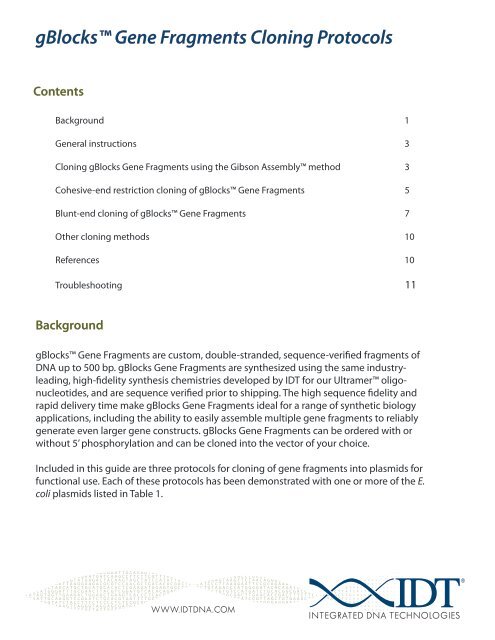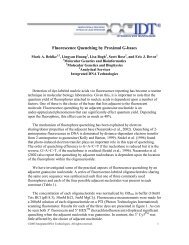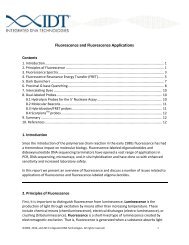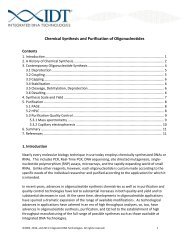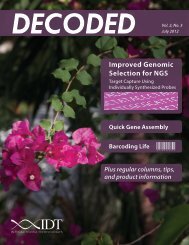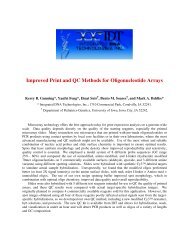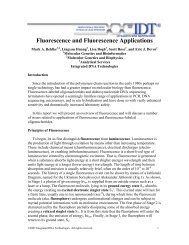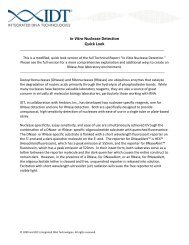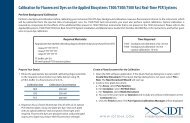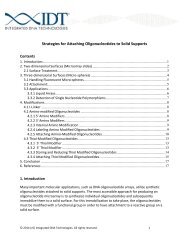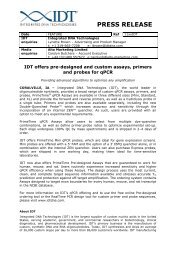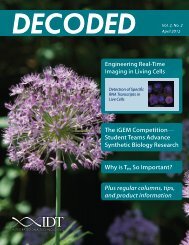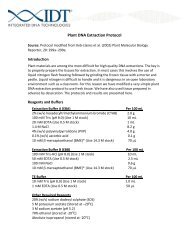gBlocks User Guide - Integrated DNA Technologies
gBlocks User Guide - Integrated DNA Technologies
gBlocks User Guide - Integrated DNA Technologies
Create successful ePaper yourself
Turn your PDF publications into a flip-book with our unique Google optimized e-Paper software.
Table 1. Evaluated Vectors and KitsVector Name Catalog # Manufacturer Restriction Endonuclease ResistancepUC57 Vector using Quick Ligation Kit SD1176-50 µg GenScript EcoRV + NEBuffer #3 AmpicillinpBluescript II KS(+) Phagemid Kit 212207Agilent<strong>Technologies</strong>EcoRV + NEBuffer #3 (BSA)AmpicillinZero Blunt® TOPO® PCR CloningKit with One Shot TOP10Chemically Competent E. coliK2875-20 Invitrogen EcoRV + NEBuffer #3 (BSA) KanamycinpET-27b(+) <strong>DNA</strong> 69863-3EMD4BiosciencesMscl + NEBuffer #4KanamycinpGem® T Easy A1360 Promega EcoRl AmpicillinpsiCHECK-2 Vector C8021 Promega Pmel + NEBuffer #4 (BSA) AmpicillinEach of the three cloning methods described here has benefits and limitations. Table 2 below will aid inselecting the appropriate method of cloning to use for your specific situation. <strong>gBlocks</strong> Gene Fragments arecompatible with most cloning protocols that require double-stranded <strong>DNA</strong> as starting material, and thefollowing is not intended to be a comprehensive listing of possible uses.Table 2. Summary of Advantages for Selected Cloning MethodsMethod Benefits DrawbacksGibson Assembly MethodCohesive-end CloningBlunt-end Cloning• Fast and efficient •• Allows for large geneassembly and generation ofgene libraries• Directional cloning• Does not require restrictionsites• Several <strong>DNA</strong> elements can beassembled in a single reaction• Directional cloning possible• More effficient than bluntendcloning• Quickest and easiest method• <strong>gBlocks</strong> fragment designdoes not requirerestriction sites*<strong>gBlocks</strong> Gene Fragmentends must complement thevector ends and ideally bedevoid of secondarystructure (includingrestriction sites forsubcloning)• Not as quick or easy asblunt-end cloning• Requires restriction sites in<strong>gBlocks</strong> Gene Fragmentand vector• Not diretional, <strong>gBlocks</strong>Gene Fragents may beinserted in either orientation• Not as efficient as the othermethods* A sequence for a restriction enzyme that produces blunt ends (e.g., EcoRV) is required in the vector multiple cloning site.For additional information and cloning protocols, see Molecular Cloning: A Laboratory Manual, by Sambrook et al. [1].Page2
General Instructions<strong>gBlocks</strong> Gene Fragments are chemically synthesized, double-stranded <strong>DNA</strong>. This means thatthey are compatible with a wide range of existing applications that require double-stranded<strong>DNA</strong>. Additionally, <strong>gBlocks</strong> Gene Fragments should be handled and stored in the same way youwould store linear, double-stranded <strong>DNA</strong>.<strong>gBlocks</strong> Gene Fragments are normalized to 200 ng and delivered dried down. The dry <strong>gBlocks</strong>Gene Fragment pellet can become displaced from the bottom of tube during shipping. Followthe instructions below for resuspending and storing your <strong>gBlocks</strong> Gene Fragments.Resuspending your <strong>gBlocks</strong> Gene Fragment:1. Centrifuge the tube for 3−5 sec at a minimum of 3000 x g to pellet the material to thebottom of the tube.2. Add 20 µL TE to the tube for a final concentration of 10 ng/µL.3. Briefly vortex and centrifuge.Storing your <strong>gBlocks</strong> Gene Fragment:<strong>gBlocks</strong> Gene Fragments can be stored in TE at −20°C for up to 24 months. If <strong>gBlocks</strong> GeneFragments will be stored for less than 1 month, they can be resuspended in nuclease-free waterrather than TE.Cloning <strong>gBlocks</strong> Gene Fragments using the Gibson Assembly Method<strong>gBlocks</strong> Gene Fragments provide flexibility for synthetic biology applications that is not currentlyavailable in any other product. The high sequence fidelity and lengths up to 500 bp mean that upto 4 <strong>gBlocks</strong> can be quickly assembled into constructs up to 2kb. The Gibson isothermal methodprovides a rapid and reliable method for joining multiple gene fragments, and is ideally suited foruse with <strong>gBlocks</strong> Gene Fragments. A simple, 30 nt sequence overlap of fragments is required inthe construct design.The Gibson Assembly method is based on the technique described by Gibson et al. [1]. Themethod relies on use of an enzyme mixture consisting of the mesophilic T5 Exonuclease, a thermophilicligase, and a high-fidelity polymerase. At high temperatures the exonuclease digestsds<strong>DNA</strong> from the 5’ ends, but is rapidly degraded leaving 3’ ss<strong>DNA</strong> ends. The 3’ ends of the <strong>gBlocks</strong>Gene Fragments and the vector are designed to complement each other and hybridize afterexonuclease digestion, at which point the polymerase and ligase fill in missing nucleotides andligate the fragments together (see Figure 1).Page3
Step 1Figure 1. How Isothermal Assemblyof <strong>gBlocks</strong> Gene Fragments Works.Step 2Step 1: <strong>gBlocks</strong> Gene Fragments aredesigned with complementary 30 bpoverlaps on the 3’ strands and used ina single 50°C reaction where thefollowing steps occur.Steps 3 and 4Step 2: A mesophilic 5’ exonucleasebriefly cleaves bases from the 5’ endsof the double-stranded <strong>DNA</strong> fragmentsbefore being inactivated at50°C.Step 3: The newly generatedcomplementary 3’ overhangs anneal.Step 5Step 4: A high fidelity <strong>DNA</strong>polymerase fills in any gaps, resultingin completed circular plasmids orretracted free ends in linearassemblies.Step 5: Finally, a thermophilic <strong>DNA</strong>ligase covalently joins <strong>DNA</strong> segments.Tips from the Bench<strong>gBlocks</strong> Gene Fragments are produced using our highest fidelity synthesis methods. However, the chance of asingle error affecting a final assembled molecule increases with the number of fragments joined. We recommendsequencing at least [2 x (number <strong>gBlocks</strong> fragments assembled)] clones to give you the highest probability ofsuccessfully identifying your desired target. For example, if you assemble 4 <strong>gBlocks</strong> Gene Fragments we recommendsequencing 8 clones to have the best chance (95%) of obtaining your desired construct.The Gibson Assembly Master Mix - New England BioLabsSince its introduction to the life science community in 2009, the Gibson Assembly method has become amainstay in the laboratories of many synthetic biologists, and is catching on in the wider life science communitydue to its ease-of-use, robustness, and flexibility. New England Biolabs (NEB) has embraced this approach forbuilding <strong>DNA</strong> constructs, and believes it will open new opportunities for researchers to manipulate complex<strong>DNA</strong>s. To enable the life science community to leverage this technology in their own labs, NEB has recentlyreleased Gibson Assembly Master Mix (NEB catalog #E2611), the first commercial product based on GibsonAssembly. More info on www.neb.com/gibsonassemblyPage4
Cohesive-end restriction cloning of <strong>gBlocks</strong> Gene FragmentsRestriction endonucleases recognize and cleave double-stranded <strong>DNA</strong> at highly specificnucleotide sequences, or restriction sites. Enzymes that create cohesive ends that can be religated are highlyuseful for cloning. Multiple cloning sites (MCS) found in all plasmids used for molecular cloning typically containseveral restriction sites. This protocol specifically describes cloning at sites producing cohesive ends.Design considerationsIt is recommended to use 2 different restriction endonucleases in your cloning design thatgenerate distinct cohesive ends. This will ensure directional cloning of the gene fragment.Many restriction endonucleases require several nonspecific nucleotides on either side of their restriction site tocut, and do not cleave efficiently when the restriction site is located at the immediate end of a <strong>DNA</strong> fragment.Information on how many bases is required for each enzyme is typically available from the manufacturer. If thatinformation is not available, we suggest adding 7 bases of sequence between the restriction sites and the freeends of the <strong>DNA</strong> insert. In addition, when preparing the vector, use restriction sites in the MCS that are separatedby a minimum of 12 bp [1].Preparing cohesive ends for vector and <strong>gBlocks</strong> Gene FragmentsDigest the <strong>gBlocks</strong> Gene Fragments and the vector separately with the appropriate restriction endonucleasesfollowing the manufacturer’s instructions. If you are performing a digestion with two restriction enzymes, eitheruse a buffer compatible with both enzymes or perform two sequential digestion reactions, removing the bufferbetween digestions [e.g., QIAquick® column (Qiagen)].1. Add the following reaction components to the digestion:Product<strong>DNA</strong>10x BufferRestriction EnzymeNuclease-free water<strong>gBlocks</strong> Fragment Page100 ng53 μL1μL (each)To 30 μLVector600 ng3 μL1μL (each)To 30 μL2. Following digestion, remove 5’ phosphates from vector using an alkaline phosphatase [e.g., Thermosensitive Alkaline Phosphatase (Promega)]. Do not dephosphorylate the <strong>gBlocks</strong> Gene Fragment.a. Note: most commercially available phosphatases can be added directly at the end of therestriction digest. Follow the manufacturer’s instructions for your chosen phosphatase.3. Following dephosphorylation, gel purify the vector to reduce background and eliminate enzymes,and quantify.4. Following digestion, purify <strong>gBlocks</strong> Gene Fragment insert with a QIAquick® column (Qiagen) andquantify. The <strong>gBlocks</strong> Gene Fragment should not be dephosphorylated.Page5
LigationWe recommend using the Quick Ligation Kit (New England Biolabs) for this reaction; however, other <strong>DNA</strong> ligaseswill also work. For efficient ligation of the <strong>gBlocks</strong> Gene Fragment into the vector, use an optimum molar ratio ofvector to <strong>gBlocks</strong> Gene Fragment. The ratio that we find works best is 1:3−1:5 vector to <strong>gBlocks</strong> Gene Fragment.1. Add the following reaction components in the order listed below, centrifuge briefly, and incubate atroom temperature for 5 min.ProductLinearized Vector<strong>gBlocks</strong> Gene Fragment2X Quick Ligase Buffer (NEB)Quick <strong>DNA</strong> Ligase (NEB)DNase- and RNase-free waterAmount50 ng3−5X molar excess*10 μL 1 μLFor a final volume of 20 μL*Molar ratios of the <strong>gBlocks</strong> Gene Fragment can be converted to ng using the following formula:50 ng x desired molar ratio x <strong>gBlocks</strong> Gene Fragment length (bp) = ng <strong>gBlocks</strong> Gene Fragment neededPlasmid length (bp)2. Transform ligation directly or store at –20°C. Do not heat inactivate.TransformationVarious lines of competent E. coli with high transformation efficiencies are available from different vendors.Alternatively, competent cells can be prepared in the lab by following the protocols outlined in Sambrook et al. [1].The following protocol uses XL1blue Cells (Stratagene):1. Thaw cells on wet ice.2. Add 25 µL cells to a pre-chilled 14 mL BD Falcon polypropylene tube on ice.3. Add 2 µL ligation mixture, mix gently.4. Incubate on wet ice for 30 min.5. Place in a 42°C water bath for 45 sec.6. Return to ice for 2 min.7. Add 250 µL SOC media to the cells and incubate, shaking at 37°C for 1 hr.8. Plate 125 µL on LB plates with the appropriate selection marker.Page6
Blunt-end cloning of <strong>gBlocks</strong> Gene FragmentsBlunt-end cloning has the least number of steps and is the fastest method of cloning <strong>gBlocks</strong> Gene Fragments. Itrequires no specific sequences near the ligation site or additional gene fragment preparation. The trade-off is thatblunt cloning is as much as 100X less efficient than cohesive-end restriction site cloning and is not directional;therefore the <strong>gBlocks</strong> Gene Fragment will be inserted randomly in either orientation. In most cases, screeningseveral colonies after transformation will identify vectors containing the desired insert orientation.Design considerations<strong>gBlocks</strong> Gene Fragments are synthesized with blunt ends, and for blunt cloning applications they should besynthesized with 5’ phosphates to facilitate ligation. In general, <strong>gBlocks</strong> Gene Fragments with low G/C contentnear the ends (e.g.,
Other cloning methodsThere are many alternative cloning methods that may be used with <strong>gBlocks</strong> Gene Fragments. <strong>User</strong>s should referto the description of the method in the original publication or user guide for commercial kits for additional information.Below we briefly present the popular TA cloning method.TA cloningSeveral commercial cloning kits use the TA cloning method. Vectors in these kits have single T base overhangs inthe vector multiple cloning site that are designed to complement the residual A base left by Taq polymerase afterPCR reactions. For <strong>DNA</strong> with blunt ends such as <strong>gBlocks</strong> Gene Fragments, the A base overhangs can be added by abrief incubation with Taq polymerase, in the presence of dATP, and then cloned using this method.Tailing ReactionThe tailing procedure modifies <strong>gBlocks</strong> Gene Fragments to have a single A base overhang on the 3’ ends, makingthe resulting <strong>DNA</strong> compatible for TA cloning kits.1. Add the following reaction components:Product<strong>gBlocks</strong> Gene FragmentTaq <strong>DNA</strong> Polymerase 10X Rxn BufferdATP (Final conc. 0.2mM)Taq <strong>DNA</strong> PolymeraseDNase- and RNase-free waterAmount5 μL 1 μL 5 unitsTo 10 μL 2. Incubate for 30 min at 70°C.References1. Gibson DG, Young L, et al. (2009) Enzymatic assembly of <strong>DNA</strong> molecules up to several hundred kilobases. Nature Methods, 6(5):343–345.2. Sambrook J and Russel DW, editors. (2001) Molecular Cloning: A Laboratory Manual. 3rd ed. Cold Spring Harbor, NY: Cold Spring Harbor Laboratory.3. Sabel J et al. (2011) IDT Mutagenesis Application <strong>Guide</strong>. Available at www.idtdna.com.Gibson Assembly is a trademark of Synthetic Genomics, Inc.Zero Blunt® and TOPO® are a registered trademarks of Life <strong>Technologies</strong>, Inc.psiCHECK is a trademark of Promega Corp, and pGEM® is a registered trademark of Promega Corp.QIAGEN® and QIAquick® are registered trademarks of the QIAGEN Group.Quick Ligation is a trademark of New England Biolabs, Inc. NEB® is a registered trademark of New England Biolabs, Inc.Page10
TroubleshootingPCR amplification of <strong>gBlocks</strong> Gene FragmentsIDT supplies 200 ng <strong>gBlocks</strong> Gene Fragments per order, which should provide enough material for direct cloningunder ideal conditions. However, if your specific experiment requires additional steps (e.g., purification) or has lowobserved efficiency, you may want to amplify your gene fragment prior to cloning to create sufficient product tosee by gel electrophoresis after digestion. Amplification will also ensure there is sufficient material to repeat thecloning, if necessary. It is highly recommended that you use a high-fidelity polymerase instead of Taq polymerasein order to limit the introduction of errors into your <strong>gBlocks</strong> Gene Fragment sequence.Synthetic Biology specialists at IDT are available to design primers for amplification of <strong>gBlocks</strong> Gene Fragments.You can order these primers in several different scales, depending on your needs. Use the following procedure toamplify <strong>gBlocks</strong> Gene Fragments with the validated primers. Please contact our gene specialists atgenes@idtdna.com for more information.Amplification of <strong>gBlocks</strong> Gene Fragment for cloning:1. Prepare PCRs with the following reaction components, being sure to include both a positive andnegative control reaction.ProductAmountNuclease-free water31 μL 10x KOD Buffer5 μL 2 mM dNTPs 5 μL MgSO43 μLKOD polymerase 2.5 U/μL1 μL5 μm Forward Primer 2 μL5 μm Reverse Primer 2 μL<strong>gBlocks</strong> Gene Fragment (10 ng/μL)1 μL2. Amplify the PCR using the following thermal cycling parameters:3 min, 98°C30X (15 sec, 98°C; 15 sec, 60°C; 15 sec, 70°C)30 sec, 70°C3. Confirm the amplification product by running 5 µL on a 0.8% agarose gel with an appropriate<strong>DNA</strong> ladder.Purify the remaining PCR product using a QIAquick® Kit (Qiagen), and eluting in 45μL, or the same volume as thePCR sample.Page11
Restriction digestionLike most enzymes, restriction endonucleases require specific conditions to functionoptimally. Make sure to always use compatible buffers and the correct incubation times andtemperatures.LigationQuantification of ProductUsing the correct concentration and molar ratio of <strong>DNA</strong> fragment and vector is critical for ligation reactions.Low concentrations will not produce sufficient product to provide enough colonies for screening. Highconcentrations (>10 μg/mL) may favor intermolecular ligation, resulting in multiple plasmids being ligatedtogether. If you observe this, decrease the concentration of the PCR product added to the ligation reactionby 2–10X.Gel purification of restriction digestionsSupercoiled <strong>DNA</strong> transforms with much greater efficiency than linear or circular <strong>DNA</strong>. Trace amounts of uncutplasmid that are carried through ligation and transformation reactions can overwhelm the number of correctlyligated products resulting in most colonies having no insert. This is particularly true with blunt cloningreactions due to the low efficiency of the reaction.Inhibitors of ligaseLigase activity can be reduced or inhibited by several factors including the following:a. High levels of salts−Desalt the <strong>DNA</strong> prior to ligation with a clean-up kit that uses a sizeexclusion column.b. Degraded ATP in the reaction buffer−Aliquot the ligase buffer into small volumes to avoid repeated freeze-thaw cycles.c. The use of deoxyribose ATP instead of ribose ATP−Nucleotides for PCR are not a substratefor T4 ligase. Note that some ligases such as Taq ligase require NADH rather thanATP as a substrate.d. An incubation time that is too short−Blunt-ended ligations often require 2 hrs atroom temperature or overnight at 16°C for maximum efficiency.e. Incubation temperature that is too high−Incubation above 20°C degrades the ligase before it can complete the reactions.f. Strong secondary structure near the ligation point−Secondary structure can cause deletions and/or rearrangements near the ligation point as well as poor ligation efficiency.Page12
TransformationHandling competent cellsFrozen competent cells are very fragile and sensitive to temperature. Once thawed, these cells should not berefrozen as a large loss of competency is likely to occur. Instead, cells should be kept on wet ice and usedimmediately. Rough handling, including rapid pipetting and vortexing, will also result in loss of competency.Heat shock considerationsProtocols for heat shock transformation vary for different cell lines and when different types of tubes are used.Choose a protocol that has been successful for the cell line you are using and follow it precisely. Small changes,such as the type of tube used and length of heat shock (e.g., even warming of cells briefly), can have largeeffects on transformation efficiency.Electroporation considerationsSmall amounts of salts greatly increase the conductivity of liquids. In electroporation reactions, this can lead tosuperheating of the transformation or even arcing of the electroporation vessel, resulting in cell death. Sinceligation reactions use high salt concentrations, it is important to desalt the <strong>DNA</strong> prior to electroporation.SelectionAntibiotic selection of ligated, transformed cells is required to eliminate those that lack the desired ligatedplasmid product. Useful ranges of antibiotics vary. In general, 100 μg/mL of ampicillin or 50 μg/mL ofkanamycin selects efficiently for high copy plasmids in most E. coli strains. Indications that antibioticconcentrations are too high are the death of antibiotic resistant cells resulting in no growth on plates. Too lowof a concentration of antibiotics results in growth of nonresistant cells. Often this is seen as a lawn or near lawnof cells at all dilutions when transformation reactions are plated. Antibiotics degrade over time and are sensitiveto heat. Low concentrations of some antibiotics such as ampicillin can lead to the growth of satellite colonies.Page13
ContaminationDifferent colored cells, filamentous growth, or inhibition of growth of E. coli on your screening plates are anindication of contamination. To address this, replace media and practice sanitary techniques.E. coli strainsMany common E. coli strains such as DH5alpha and its derivatives work well for most cloning applications.Plasmid genomes that are large (greater than 8 kb) and have high degrees of secondary structure, high GCcontent, and/or homology to the host genome may recombine within the host genome resulting in deletionsand rearrangements, often within one area of the plasmid. The use of E. coli strains engineered to have loweredrecombination or designed for use with large plasmids can sometimes decrease this recombination. Examplesof these types of cells are the Stbl3 line (Life <strong>Technologies</strong>) and the XL10 gold line (Stratagene).Toxic sequencesSequences that code for toxic products, or products that interfere with normal cellular metabolism, cause poortransformation efficiency, high background–and/or a lack of correct ligation products. Silent changes to thecoding sequence may help alleviate this toxicity, as well as altering the plasmid to have a lower copy vector.WWW.IDT<strong>DNA</strong>.COMINTEGRATED <strong>DNA</strong> TECHNOLOGIES


